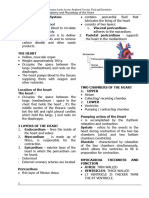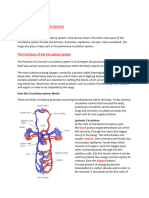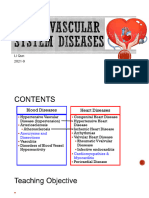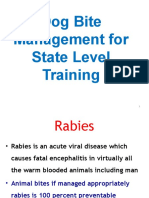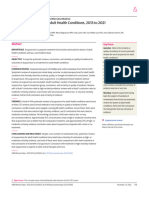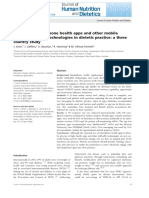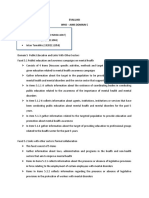Cardiac Musclet PDF
Cardiac Musclet PDF
Uploaded by
مؤمل كامل عبد العالي هريسCopyright:
Available Formats
Cardiac Musclet PDF
Cardiac Musclet PDF
Uploaded by
مؤمل كامل عبد العالي هريسOriginal Title
Copyright
Available Formats
Share this document
Did you find this document useful?
Is this content inappropriate?
Copyright:
Available Formats
Cardiac Musclet PDF
Cardiac Musclet PDF
Uploaded by
مؤمل كامل عبد العالي هريسCopyright:
Available Formats
Cardiac muscle (also called heart muscle or myocardium ) is one of three types of vertebrate muscles,
T R R R R9
with the other two being skeletal and smooth muscles. It is an involuntary, striated muscle that
T U
constitutes the main tissue of the walls of the heart . The myocardium forms a thick middle layer
T RR
between the outer layer of the heart wall (the epicardium) and the inner layer (the endocardium), with
R T R
blood supplied via the coronary circulation . It is composed of individual heart muscle cells
T R R
(cardiomyocytes) joined together by intercalated discs, encased by collagen fibers and other substances
T R R
that form the extracellular matrix T.T
Cardiac muscle contracts in a similar manner to skeletal muscle, although with some important
R R R R R R R R R
differences . Electrical stimulation in the form of an action potential triggers the release of calcium from
R R
the cell's internal calcium store, the sarcoplasmic reticulum . The rise in calcium causes the cell's
R R
myofilaments to slide past each other in a process called excitation contraction coupling.
R R R
Diseases of the heart muscle Rare of major importance . These include conditions caused by a restricted
R R R R
blood supply to the muscle including angina pectoris and myocardial infarction, and other heart muscle
R R R
diseases known as cardiomyopathies.
You might also like
- CVS Module Histo 2 24 25Document32 pagesCVS Module Histo 2 24 25moneergousousNo ratings yet
- 3 Cardiovascular PhysiologyDocument79 pages3 Cardiovascular PhysiologyJose Luna100% (3)
- Physiology of The Normal Heart: Key PointsDocument5 pagesPhysiology of The Normal Heart: Key PointsGustavo TejerinaNo ratings yet
- Pathophysiology of Heart Disease - A Collaborative Project of Medical Students and Faculty (PDFDrive) - 12-19Document8 pagesPathophysiology of Heart Disease - A Collaborative Project of Medical Students and Faculty (PDFDrive) - 12-19nurul hidayatiNo ratings yet
- WEEK 1 MEDSURG AsynchDocument12 pagesWEEK 1 MEDSURG AsynchLeigh Angelika Dela CruzNo ratings yet
- Anatomy of HeartDocument5 pagesAnatomy of HeartJazel TirolNo ratings yet
- 11 Cardiovascular SystemDocument19 pages11 Cardiovascular SystemRIGIL KENT ORAANo ratings yet
- Structures and Layers of The Heart AtfDocument4 pagesStructures and Layers of The Heart AtfSudip HalderNo ratings yet
- (Transes) Human Histology - 11 Cardiovascular SystemDocument22 pages(Transes) Human Histology - 11 Cardiovascular SystemReina CastronuevoNo ratings yet
- CARDIOVASCULAR SYSTEM HLTDDocument2 pagesCARDIOVASCULAR SYSTEM HLTDa24-1018-520No ratings yet
- Medical Surgical Nursing: Anatomy HeartDocument8 pagesMedical Surgical Nursing: Anatomy HeartRoyce Vincent TizonNo ratings yet
- Cardio VascularDocument42 pagesCardio VascularMamta ShuklaNo ratings yet
- Biochemistry N Physiology of Cardiac MuscleDocument4 pagesBiochemistry N Physiology of Cardiac MuscleNadila FaatinNo ratings yet
- Circulatory System PDFDocument5 pagesCirculatory System PDFNibshian Dela RosaNo ratings yet
- Circulatory System REVIEWERDocument6 pagesCirculatory System REVIEWERClyde BaltazarNo ratings yet
- Anatomy of The Heart: Materials Pre-Lab QuizDocument14 pagesAnatomy of The Heart: Materials Pre-Lab QuizAnonymous dRAu54No ratings yet
- SB0024 Transport in Animals and Plant (DFN)Document80 pagesSB0024 Transport in Animals and Plant (DFN)jmyphjmrdnNo ratings yet
- Cardiovascular Neurologic NursingDocument7 pagesCardiovascular Neurologic Nursingjulia marie candelarioNo ratings yet
- Functions of The Cardiovascular SystemDocument14 pagesFunctions of The Cardiovascular SystemJamaica SimanganNo ratings yet
- Anaphy LabDocument18 pagesAnaphy LabvielesamyzfNo ratings yet
- Anaphy Chapter 20 Heart Doran Mls 1 FDocument10 pagesAnaphy Chapter 20 Heart Doran Mls 1 FayenaNo ratings yet
- Chapter 9 - Med Physio (GP)Document14 pagesChapter 9 - Med Physio (GP)Ritch Jerielyn HaliliNo ratings yet
- Cardiovascular System - The HeartDocument37 pagesCardiovascular System - The HeartCecil AlbaNo ratings yet
- Introduction To CVS & Cardiac Muscles PropertiesDocument11 pagesIntroduction To CVS & Cardiac Muscles PropertiessadiqnawaabNo ratings yet
- Transe 3Document8 pagesTranse 3lija.medija.swuNo ratings yet
- Cardiovascular DisordersDocument16 pagesCardiovascular DisordersTanwir HoussaynNo ratings yet
- Med-Surg-CardioDocument18 pagesMed-Surg-Cardiojakecastillo407No ratings yet
- Topic - 7 - Lec - Heart and Blood VesselsDocument10 pagesTopic - 7 - Lec - Heart and Blood Vesselsannamabalot3No ratings yet
- Cardiopulmo Notes 2ndDocument12 pagesCardiopulmo Notes 2ndCherrie MaeNo ratings yet
- Cardio 1Document7 pagesCardio 1Moon KillerNo ratings yet
- Cardiovascular System: Anatomy and PhysiologyDocument10 pagesCardiovascular System: Anatomy and PhysiologyDavid PunzalanNo ratings yet
- Circulatory SystemDocument8 pagesCirculatory SystemDany MonteroNo ratings yet
- AngiologyDocument65 pagesAngiologymoi2apuiaNo ratings yet
- Cardiovascular System Anatomy and PhysiologyDocument14 pagesCardiovascular System Anatomy and PhysiologyKIRSTEN CHAVEZ100% (1)
- 1.08 - The Cardiovascular System, The Heart & The Blood VesselsDocument9 pages1.08 - The Cardiovascular System, The Heart & The Blood Vessels13PLAN, SENTH RUEN, ANo ratings yet
- Cardiovascular SystemDocument7 pagesCardiovascular SystemLily Andrea MrcNo ratings yet
- (Harsh Mohan) Textbook of Pathology (6th Ed.) - 433-476Document44 pages(Harsh Mohan) Textbook of Pathology (6th Ed.) - 433-476Ananta DasNo ratings yet
- L1 Histo??Document8 pagesL1 Histo??Ahmed MohamedNo ratings yet
- Anaphy (Chapter 20 The Heart)Document21 pagesAnaphy (Chapter 20 The Heart)TeresilleNo ratings yet
- CardiovascularSystem - Worksheet 2020-2Document2 pagesCardiovascularSystem - Worksheet 2020-2lisamontague02No ratings yet
- The Circulatory SystemDocument97 pagesThe Circulatory SystemoatcookiesNo ratings yet
- Anatomy and PhysiologyDocument12 pagesAnatomy and PhysiologyGregg PalabricaNo ratings yet
- Anatomy and Physiology MidtermsDocument19 pagesAnatomy and Physiology MidtermsteressaubungenNo ratings yet
- Cardio TransesDocument18 pagesCardio TransesJustine AbongNo ratings yet
- MMH Study GuideDocument28 pagesMMH Study GuidescotchtapestickyNo ratings yet
- Cardio Pulmo NotesDocument12 pagesCardio Pulmo NotesCherrie MaeNo ratings yet
- Body Fluids & CirculationDocument29 pagesBody Fluids & CirculationAyaan AshrafNo ratings yet
- Cardiopulmonary System: Relevant Anatomy & Physiology: HeartDocument12 pagesCardiopulmonary System: Relevant Anatomy & Physiology: HeartJulia SalvioNo ratings yet
- Na Bee Baccus 2014Document5 pagesNa Bee Baccus 2014Karglem David Torres MartínezNo ratings yet
- 6.-CARDIOVASCULAR-SYSTEM - (BSCC & Pharma)Document19 pages6.-CARDIOVASCULAR-SYSTEM - (BSCC & Pharma)ShakshamNo ratings yet
- Notes On Cardiovascular SystemDocument3 pagesNotes On Cardiovascular Systemmohamed waleedNo ratings yet
- Circulatory System VCE BiologyDocument6 pagesCirculatory System VCE BiologyCallum KennyNo ratings yet
- Ms - CardiovascularDocument70 pagesMs - CardiovascularMark OngNo ratings yet
- CARDIO 1. Assessment and Diagnostic - ReviewerDocument21 pagesCARDIO 1. Assessment and Diagnostic - ReviewerMark OngNo ratings yet
- Chapter 11Document4 pagesChapter 11Nona PeriarceNo ratings yet
- Human Circulatory SystemDocument8 pagesHuman Circulatory SystemChelsea EdwardsNo ratings yet
- 1-Atherosclerosis Team441Document14 pages1-Atherosclerosis Team441Somchai PtNo ratings yet
- Med Surg CardioDocument18 pagesMed Surg CardioRianne Marie MarasiganNo ratings yet
- 9. Cardiovascular Diseases 1Document156 pages9. Cardiovascular Diseases 1Muhammad Awais NoorNo ratings yet
- A Simple Guide to the Heart beats, Related Diseases And Use in Disease DiagnosisFrom EverandA Simple Guide to the Heart beats, Related Diseases And Use in Disease DiagnosisRating: 5 out of 5 stars5/5 (1)
- Inggris Sop Mengukur Tanda Tanda Vital - Id.enDocument3 pagesInggris Sop Mengukur Tanda Tanda Vital - Id.enIffaNo ratings yet
- SESSION 2021-22: Chemistry Investigatory ProjectDocument14 pagesSESSION 2021-22: Chemistry Investigatory ProjectsaharyaNo ratings yet
- Trans SaVi Lec08 Obstetrics Post Term Pregnancy 1st SemesterDocument7 pagesTrans SaVi Lec08 Obstetrics Post Term Pregnancy 1st SemesterAdrian CaballesNo ratings yet
- Syndroms Suggestive of Ischemia or Infarction: EMS Assessment and Care and Hospital PrepartionDocument8 pagesSyndroms Suggestive of Ischemia or Infarction: EMS Assessment and Care and Hospital PrepartionNugroho TeguhNo ratings yet
- Caries Risk AssessmentDocument5 pagesCaries Risk Assessmentmatingin.aileen11No ratings yet
- Hand Hygiene: Panitia Pengendalian Infeksi Nosokomial. Dr. Ahmad D. SudrajatDocument40 pagesHand Hygiene: Panitia Pengendalian Infeksi Nosokomial. Dr. Ahmad D. SudrajatpedsquadNo ratings yet
- Effect of Hypoxic Conditioning On Functional Fitness, Balance and Fear of Falling in Healthy Older Adults: A Randomized Controlled TrialDocument8 pagesEffect of Hypoxic Conditioning On Functional Fitness, Balance and Fear of Falling in Healthy Older Adults: A Randomized Controlled Trialkhaled mohamedNo ratings yet
- Fda Approves Alzheimer'S Drug Amid Safety ConcernsDocument2 pagesFda Approves Alzheimer'S Drug Amid Safety ConcernsAdrian Dacosta LazeraNo ratings yet
- DG MFA EXIT EXAM QUESTIONS AND ANSWERS 3.0 - Part CDocument6 pagesDG MFA EXIT EXAM QUESTIONS AND ANSWERS 3.0 - Part CDiptendu ParamanickNo ratings yet
- Addressing Wound Chronicity FactorsDocument5 pagesAddressing Wound Chronicity FactorsSaiyan DianNo ratings yet
- Dog Bite ManagementDocument94 pagesDog Bite ManagementHari Krishnan ElangovanNo ratings yet
- Sample of Essay - The FluDocument2 pagesSample of Essay - The FluMerisa WahyuningtiyasNo ratings yet
- E Book Sexual Health Wellness Aqpd9tDocument20 pagesE Book Sexual Health Wellness Aqpd9tdr NayanBharadwajNo ratings yet
- Allen 2022 Oi 221230 1668537399.79256Document16 pagesAllen 2022 Oi 221230 1668537399.79256JonasMarçaloNo ratings yet
- Introduction To Toxicology: Richard R. Rediske, Ph.D. Annis Water Resources Institute Grand Valley State UniversityDocument57 pagesIntroduction To Toxicology: Richard R. Rediske, Ph.D. Annis Water Resources Institute Grand Valley State UniversityDyah Ayu pramoda wardaniNo ratings yet
- Lice Infestation and ControlDocument16 pagesLice Infestation and ControlOnwubalili KelvinNo ratings yet
- 3 BrothersDocument6 pages3 BrothersM. Chiara AlessiNo ratings yet
- Adult Headache GuidelineDocument7 pagesAdult Headache GuidelineKhairunisaNo ratings yet
- Trust in Science A Novel Research Partnership Model in Latin AmericaDocument2 pagesTrust in Science A Novel Research Partnership Model in Latin AmericaMirnaFloresNo ratings yet
- Complications of SinusitisDocument96 pagesComplications of Sinusitiskamal saudNo ratings yet
- Self-Declaration / Undertaking by Research Scholar / Student / (Returning To IITM Hostel)Document3 pagesSelf-Declaration / Undertaking by Research Scholar / Student / (Returning To IITM Hostel)Laxmith ShettyNo ratings yet
- Exercise To Lower LDL - Web MDDocument3 pagesExercise To Lower LDL - Web MDjferrell4380No ratings yet
- Detailed Lesson Plan in Health For Grade 10Document12 pagesDetailed Lesson Plan in Health For Grade 10Jenz Rey Justo67% (3)
- The Use of Smartphone Health Apps and Other Mobile Health (Mhealth) Technologies in Dietetic Practice - A Three Country StudyDocument14 pagesThe Use of Smartphone Health Apps and Other Mobile Health (Mhealth) Technologies in Dietetic Practice - A Three Country StudyUmialqyNo ratings yet
- Osha 30 Final Exam With 100 Questions and Answers Latest Updated 2024Document8 pagesOsha 30 Final Exam With 100 Questions and Answers Latest Updated 2024felixom.0018100% (1)
- Emerging and Reemerging Infectious DiseasesDocument13 pagesEmerging and Reemerging Infectious DiseasesSayu100% (1)
- Chapter I The Problem and Its ScopeDocument57 pagesChapter I The Problem and Its ScopeJhon Keneth NamiasNo ratings yet
- EVALUASI Domain 5.3Document3 pagesEVALUASI Domain 5.3indah julianaNo ratings yet
- CH 6 Geo PopulationDocument11 pagesCH 6 Geo Populationmanishksethi10c2024No ratings yet
- Lachesis MutusDocument9 pagesLachesis Mutusrathinasabapathy saravananNo ratings yet





























